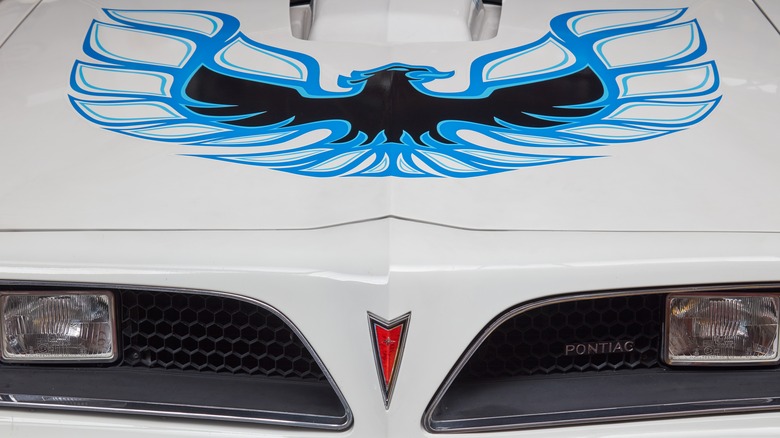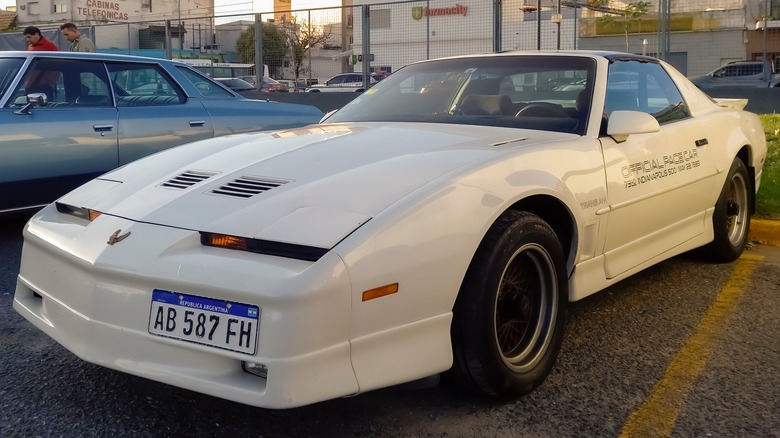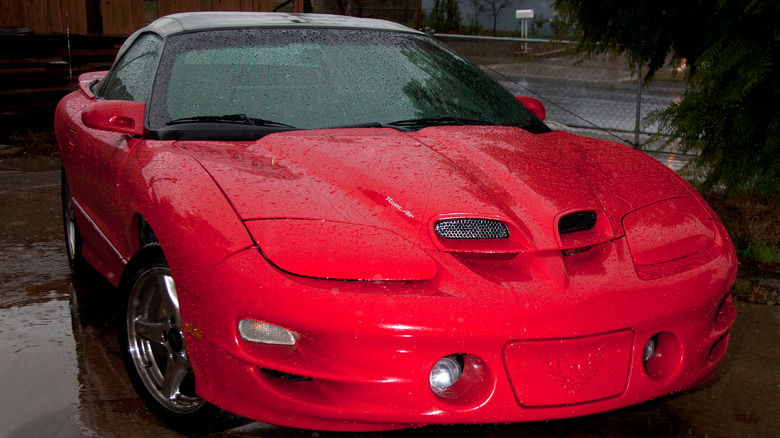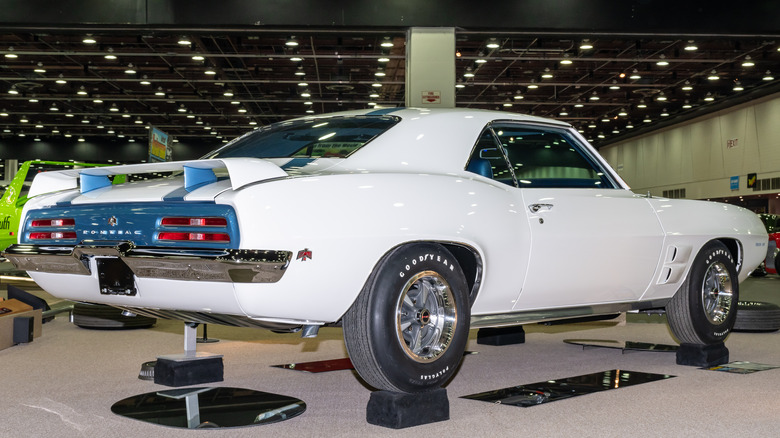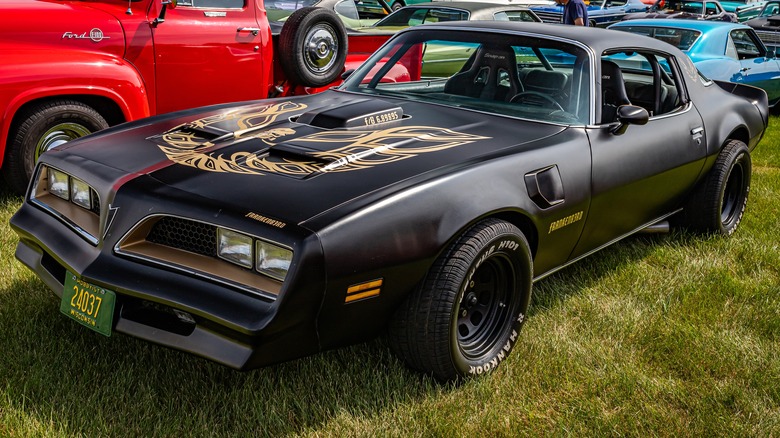Every Generation Pontiac Trans Am, Ranked Worst To Best
It was the middle of the 1960s, and American car manufacturing was on the cusp of what would be one of its greatest eras. Gasoline was cheap, meaningful emission regulation was years away, and the biggest engine crammed into the lightest car was the most direct route to performance.
Pontiac helped kickstart the era with the GTO, but General Manager John Delorean wanted something more along the lines of a sports car. Despite Delorean's support of the Corvette-like Banshee prototype, GM decided it wanted an F-body competitor to Chevrolet's Camaro. Delorean made the most of the opportunity by putting his engineering department on developing the Firebird. But not just any Camaro clone would do. Delorean wanted a car that would beat the Z/28 at its own game.
The result was the Pontiac Firebird Trans Am package. Named after the Trans American racing series as a nod to its performance-oriented mission, the Trans Am spanned four decades as Pontiac's premier performance vehicle. In production between 1969 and 2002, the Trans Am's career far outlasted the muscle car glory days.
Which of the four generations of Trans Am is the best, though? In our guide to every generation of Pontiac Trans Am ranked worst to first, we examine each generation based on cost, performance, availability, rarity, and accessibility to determine which is worth your attention.
Last Place: third generation (1982-1992)
It's no secret that American performance cars of the 1980s suffered. The Clean Air Act of 1970 put a nail in the coffin of high-displacement American V8 power, and the oil embargoes of 1973 and 1979 shoveled dirt over the casket. The Proud V8s that had once thundered under the hood of the Trans Am were detuned and strangled by emission and fuel-efficiency regulations, resulting in a sorely underpowered "muscle" car.
In 1982, the Trans Am, equipped with a 5.0 HO V8, produced 189 hp. That number increased over the decade of third-generation production, but only to 205 hp. It was a far cry from the glory days. For reference, the 1967 Firebird Sprint was powered by an in-line six-cylinder engine and produced 215 hp.
Upon introduction in 1982, the Trans Am looked speedy and slick. Shaving 500 pounds from the previous generation, the lighter, wedge-shaped vehicle looked ready to cut through the air. Fast-forward to today, and the once-futuristic design now looks hopelessly dated, like an anachronistic futurist's idea of what cars would one day look like.
Still, there's a bright side: The 1980s Trans Am remains fairly accessible, with the average price today being around $22,000 and on the low end sell for as little as $4,000. And who is to say these cars won't become collectible in the near future? Still, fans might start elsewhere if they're trying to get into the driver's seat of a Trans Am.
Third place: fourth generation (1993-2002)
It almost seems shameful to place the fourth-generation Trans Am this low on the list. With an average price on the used market of $25,590 and a low of $5,500, the final form of the Trans Am is only a tick more expensive than its far inferior third-generation predecessor. One common complaint about this generation of Trans Am is its interior quality. The hard plastics and basic fabrics did not wear well — but if you want comfort, buy a Cadillac, right? Trans Am fans who want in without breaking the bank would do well to take a look at the fourth-gen.
Built between 1993 and 2002, advancing technology helped Pontiac overcome some of the '80s power woes. For starters, engineers increased displacement from 5.0 liters to 5.7 liters. The result was 275 hp and 325 lb-ft of torque — an enormous improvement over the 1992 model's numbers. Mated to a six-speed transmission, the new Trans Am was geared for fun. Gone was the speed wedge shape, and in its place, you got a muscular stance and fire-breathing snout that reminded onlookers the Trans Am was a muscle car. Post-1998 models got a front-end redesign that doubled down on the I'm-coming-to-eat-your-children-on-the-racetrack vibe.
General Motors put the axe to the Firebird in 2002, and Pontiac itself would shut its doors only six years later. By then, horsepower had crept up to 310, respectable by the day's standards and a suitable swan song for the legendary name. It's one of the coolest looking Pontiacs ever made, too.
Second Place: first generation (1969)
This may be controversial. How do we place perhaps one of the most beautiful cars in the history of American design in second place? Here's the thing: All of the good things about the first generation Trans Am are true. It's gorgeous, powerful, the beginning of an era... and so rare as to be virtually priceless, with an average cost of $134,336 on the used market. We're all grateful to the one-percenters who purchase and maintain these cars, but at a certain point, they become prohibitively expensive. The lowest sale currently on record for a 1969 Trans Am is $55,000.
The first Trans Am arrived in March of 1969, touted as a high-performance package with improved handling, power, and cosmetics. The $725 option was ordered on no more than 697 coupes and eight convertibles, explaining the rarity now driving up the price.
A 400 cubic-inch V8 with Ram Air induction produced around 335 hp. Power steering came standard, and with the power output not much greater than standard Firebirds, the Trans Am focused on handling. A heavy-duty suspension and stabilizer bars kept body roll to a minimum, making the Trans Am stand above competitor's heavy straight-line beasts.
Few owners would be willing to sling an original 1969 Trans Am around the track, but it's hard to argue with classic muscle car lines and a verifiable racing pedigree.
First Place: second generation (1970-1981)
No sooner did the 1969 Trans Am hit the streets than Pontiac ordered a complete redesign. 1970 was a pivotal year for muscle cars. Most had been in their first generation for a few years by then, and keeping up with the competition meant major design changes.
The 1970 model kept the Ram Air 400-cid V8 from the '69 model. Stiff springs and sway bars, along with variable-ratio power steering, stayed true to the road-racing mission, and Pontiac claimed 50 pounds of downforce at speed thanks to a collection of air dams and spoilers.
Evoking a Trans Am recalls the iconic second generation's long-hooded, swept-back design, with a glorious phoenix emblem adorning the shaker hood. If you're looking for a Trans Am out of "Smokey and the Bandit," it's this generation.
The longest production run of any Trans Am is a mixed blessing. As the seventies unwound into a series of gas crises and emission-slashing government regulations, the Trans Am suffered. By 1981, the premier engine choice was a 301 cubic-inch turbocharged V8, putting out around 200 hp.
The upside of this de-evolution and long production span is that the second-generation Trans Am remains accessible. The 1970 model currently has an average cost of $79,000 on the used market, but the less desirable late models are far more reasonable. The average cost of a 1981 Trans Am is $32,700, with the lowest sale price of $7,000. Not only is the second-gen a verified icon, but it is still accessible to amateur mechanics who want to build one themselves.
